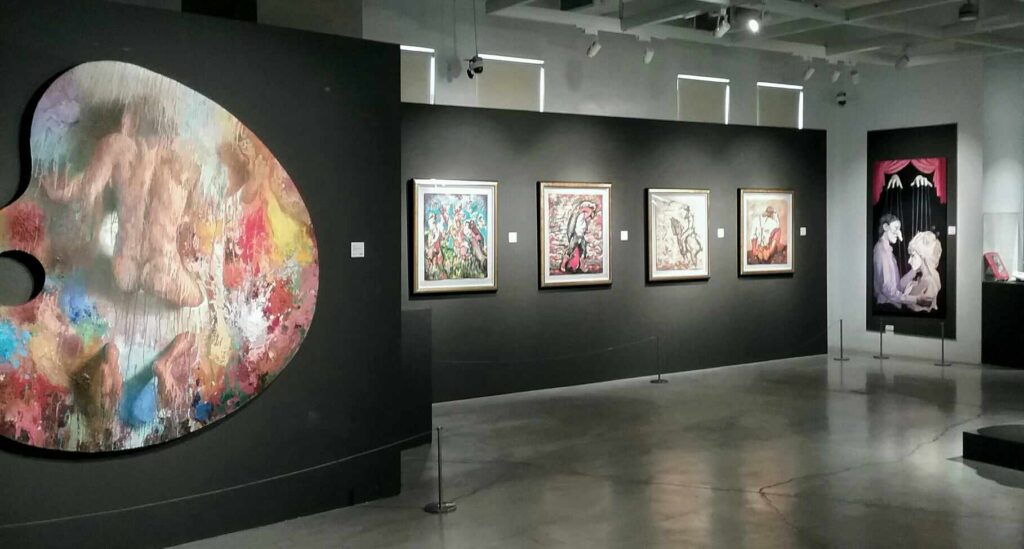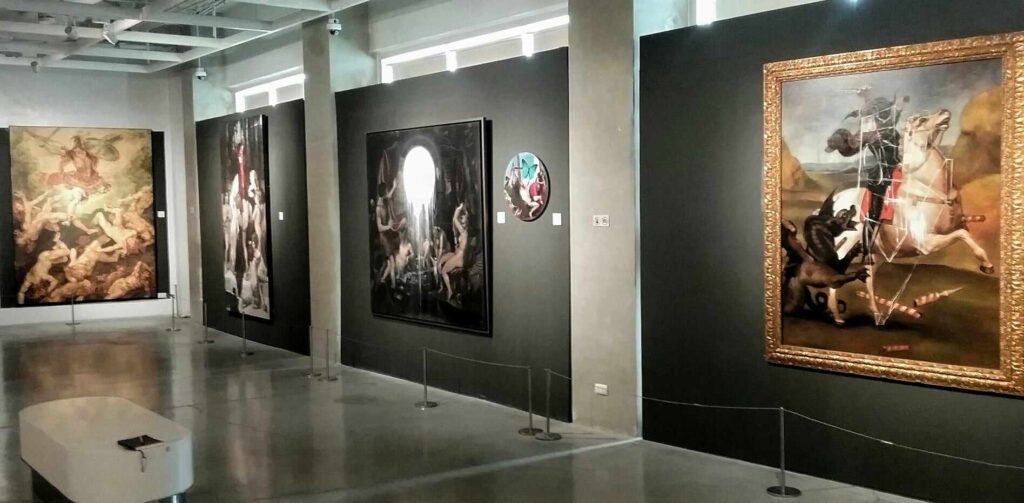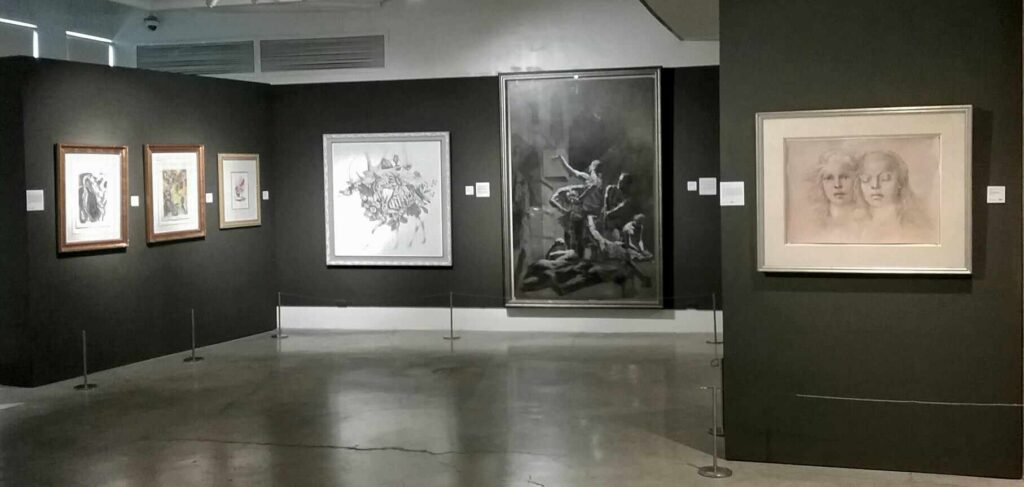Ah, the Italians! The surreptitious allure of the Mona Lisa’s smile and the overwhelming magnitude of the frescoed ceiling of the Sistine Chapel – ask anyone with a sprinkling of art education about Italian art and you would hear about these familiars ad nauseam. We can hardly blame them: to encapsulate all the centuries devoted to the Beautiful to this encyclopedic entry of one frame by da Vinci and one painted ceiling by Michelangelo [who was primarily a sculptor] is perhaps a product more of a poor arts curriculum rather than poor artistic taste. Needless to say, people flock to the Louvre and the Vatican for the cliché.
Likewise, rarely does one truly pause and immerse one’s self in Italian art. Of course, there is the occasional Vivaldi concerto or that Verdi march every graduation. We more or less dozed through that lecture about chiaroscuro or impasto. One hardly glances at architecture patterned after Roman designs and who pauses to contemplate about that coarse copy of The Last Supper hanging at the dining hall?
Perhaps our history books are much kinder than our aesthetic sensibilities. Discuss painting in depth and names like Giotto, Caravaggio, Raphael, Titian, Botticelli, and Tintoretto, among others, abound vying each other in technique and topic. Or in sculpture, for that matter: Michelangelo’s marbles are divinely sublime and who can deny the humaneness in the frozen figures of Bernini or the humanity of the metalworks of Cellini? Suffice it to say that if one is to look for an enduring artistic influence – or an aesthetic hegemony that goes beyond which is strictly Art – Italian culture and lifestyle through the centuries would have more than its fair share of inspiration and gatekeeping.
Currently, a choice selection of Italian-inspired artworks from Mr. Edwin Valencia’s extensive collection is on display at the Iloilo Museum of Contemporary Art. La Vita nell’ Arte is the museum’s exploration of this Mediterranean influence in aesthetics, putting together an eclectic selection of artworks of various international artists which intersect through artistic references, mythologies, narratives, and schools of thought identified with Italy and its environs.
A cursory glance at the canvases, prints, and installations reveals that we have not truly removed ourselves from the classical canon or its variations. It goes without saying that in art, all roads still lead to Rome.

The pensive nakedness of the human corpus
Roman architect Vitruvius – immortalized in name by da Vinci’s spread-eagled sketch – maintained that all artificial structures must exemplify strength, utility, and beauty: attributes readily found in the human body. For the builder, the perfection of forms is embedded in the dimensions of the human form and one need but look into the sculpture that embellished their architecture to find this elevation of the corpus. For whatever theology may be gleaned from the idea, classical Greece and Rome created their gods in the image and likeness of man.
Small wonder that the human form steals the limelight of the exhibit: the corpus of art revolving around the corpus of man.
Take Jayson Cortez’s Chaos. With its two nearly symmetrical naked male figures kneeling away from each other in anguished postures and expressions, it recalls the mythic cosmogony of the making of the universe. Transfixed nebulously at the center of the two figures is Michelangelo’s Creation panel from the Sistine ceiling, juxtaposing Christian imagery with pagan myth, the two iterations of sacredness projected in the human figures: it is both physical violence and sacrosanct solemnity that saw the beginning of things, and the making of man is the core of it all.
By extension, this exposition of the human corpus lends itself into the speculative exploration of meanings attached to the image. American painter Adam Miller’s interpretation of Odysseus – a personal favorite, by the way – makes its viewer question the unwritten dialogue of the scene. Filling up the entire canvas is the figure of the intrepid Ithacan clad in a modern rubber suit. Surrounding him are the Sirens, androgynous figures redolent with fang, claw, and wing, biting him even as they seem to whisper their dark song to his ears. As if to respond to the unheard melodies, Odysseus’s face is ecstatic at an orgasmic level, his visage transfixed in a grimace which leaves the viewer asking if whatever was revealed to him brought him to the heights of pleasure or to the depths of pain.
The juxtaposition of the human form with floral and faunal imagery further heightens this introspectively humanist understanding of Being and how it relates to the Other. While Italian literature abounds with phantasmagorical interactions that materialize through masques and festas, the influence on art is much subtler though not necessarily diminished. Gromyko Semper’s The Disrobing of the Bachelor by His Bride, an homage to Duchamp’s art, retains the naked corpus, one female and the other as a tikbalang of local myth, with overwrought flowers and buds set to a dark night sky: in the canvas, who is the man and who is the monster? In the act of disrobing, who was revealing what?
On the other extreme, Nunzio Paci’s Evasion of a Thought altogether removes the human form altogether and replaces it with an equine skeleton, brimming with the same floral potpourris – the remainder perhaps of fleeting ruminations? Surreally nightmarish (pun intended), they cut across mere images of the body (i.e. Being) and draw us to delve inwards to the Self, recalling the Wildean dictum that all art is at once surface and symbol, and one reads and goes beneath either at his own peril.

The drama of the social animal
The complexity of the human Self and its corollary identities are always tied to the interactions and circumstances that surround it. The Italian humanists only understood too well that any portrait of the individual eventually transcends as a portrait of the times: the contemplation of the Self becomes a contemplation of the social fabric that interweaves experiences and encounters in a more well-rounded human narrative that gives existence its meaning, as eloquently expressed in the poetry of Whitman: ‘That you are here – that life exists and identity,/That the powerful play goes on and you may contribute a verse.’
Where else can that powerful play be seen through the centuries if not through art? To peer at the artificiality of art is to celebrate the Self.
The masked figures of Vanessa Schiavone’s I’m Here, I Am Not Here capture the familiar faces (or the lack of these?) of the festive Venetian masquerade but it also comments as well on the existential quandary of being reduced to mere puppets on a string, devoid of identity or will. Reverberant to this distortion of identities, the sprawling canvases of Thai artist Pat Yingcharoen recreate works by Titian and Bouguereau but with its main subjects deliberately defaced and marred; the rest of his subjects are likewise blemished with lashes of paint, as if to garble the characteristic attributes of these figures.
This social drama emanating from the sharing (or obscuration) of identities provide an interesting commentary on how people observe and participate in the aesthetic. For instance, the diminutive spectators of Toti Cerda’s Adoring Rubens’s Adoration of the Magi turn their back to the audience, yet they clearly become visual extensions of ourselves; the proportion of their sizes perhaps an addendum about our trifling lives compared to the magnitude and renown of the artwork. While for the most part, the canvas is clearly an hommage to Rubens’s technique and style (a worthy feat in itself), it further emphasizes how we spectate the spectators as they become the subjects of the artwork: do we not see ourselves in their identity-less backs?
In a curious reversal of subjects, Nicola Verlato’s Homage to Luna Y Novicio’s Spoliarium endows the familiar Filipino artwork with an unfamiliar perspective: rendered in shades of gray, white, and black, an immense menagerie of human figures frozen in dramatic poses, encased (or should it be ‘trapped’?) in a glass case, as if magnifying the pathetic and sordid situation that forever binds Luna’s subjects in utter and abject misery. An interesting conversation with the curator queried if the glass framing was meant to deliberately mirror the viewer, as if to situate and amalgamate him or her to the frenzied drama transpiring in the artwork.
The spectacle of our interactions and our continuous search for personal meanings (and meaningfulness) among these is a recurrent motif in their canvases, elevated to the level of a somber yet terrifying seriousness. And if we find these too tragic to our taste, the vibrant oils and acrylics of Sandro Chia are perhaps more to our liking – what with their vignettes of the quotidian. Or Charlie Co’s iconic bright hues may offer us a cheerful contrast to the moribund and the morbid. Euphoric or miserable, it just gives credence that it is the spectator and not life that art usually surreptitiously reflects.

Dall’Alpi a Sicilia: Italian-flavored art?
Sparked by the rediscovery of the classics, Italian humanism shifted the intellectual focus from the divine to the human in a renascent outpouring that manifested itself into art, architecture, music, and literature. Rejuvenating the integral study of philosophy, it built upon the fragments of the classical world a new perspective that would influence the subsequent centuries of art and artmaking.
This influence has not rubbed off; on the contrary, it has permeated itself into a universal legacy of aesthetic references, one that surfaces in an internationality of cultures. Whether as straightforward sketches and prints – the likes of the works of Pier Luigi Cesarini and Marc Chagall – or as immense canvases evocative of religious scenes and images.
Standing out for its attention to detail, Jay Ticar’s Kingpin puts together a conglomeration of Italian influences in architecture, highlighting intricacies that usually escape the viewer’s eye. Projecting a flattened cathedral ceiling, the buttress and columned spires soar in a forced trompe l’oeil, almost dwarfing the soaring arches and pilasters that hold up the structure. Superimposed at the center of the canvas are frames overwrought with ornate filigrees and curlicues, shrouding an obscured representation of the Almighty as the Divine Architect, grasping a compass-divider stretched over a decorative orb: a subtle nod to the artwork’s title and its theological narrative projected through forms and designs.
For one, Italian literature (not necessarily religious) abounds with themes ripe for cotemporaneous interpretations in art: for instance, Richard Thomas Scott’s Vesuvius unabashedly captures the crossing of a white-clad figure at the River Styx, making an ingress to an infernal pantheon on whose portals are emblazoned the all too-familiar warning of Dante: Lasciate ogni speranza, voi ch’entrate (Abandon all hope, ye who enter). As if to reinforce this ominous verse, the wily volcano spews out steam at the background, obfuscating the stately Roman pines in an atmosphere of pathos, uncertainty, and foreboding.
Composed of dwarfed brass equine figures arranged on a dried-up log, Ferdinand Cacnio’s Horses canter in a column, recalling a recurring Latin verse from Ovid and Christopher Marlowe: O lente, lente, currite noctis equi (‘How slow, how slow run the horses of the night’) The horses, transfixed on their equestrian pathway, suggest their frenzied stride – no destination is implied – yet they are also ironically transfixed forever, hinting on the lethargy of the act: moving yet unmoved. With whatever symbolic meanings may be attached to the animal, their suspended movement and placement at the exhibit’s entrance evoke a transitory passing – a bequeathing of sorts – continuously galloping forward yet also here to stay. Emblematic of Italian art and its influence to our understanding of aesthetics, they will endure – because they are meant to endure: Dante, Michelangelo, and Bernini, from the Alps to Sicily – to Rome and to the rest of the world, urbi et orbi.
* * * * *
In the wall-text for the exhibit, museum curator Cristal Esguerra points out the ubiquitous impermanence of life and the encompassing catholicity of art, as projected through and juxtaposed with beliefs, values, and ideas that may be foreign to both artist and audience. Notwithstanding the Italian ‘flavor’ of the artworks, walking through the floor of the exhibition is to pass through a gauntlet of ontological perspectives: that which is real – or ought to be real – is subjected through stages and phases of passion, anger, spite, love, regret, denial, oppression, jealousy, terror, ecstasy, and every other crumb of human emotion and sentiment that constitutes a life well-lived and well-spent.
But such is the basic intention of all art – all the vicissitudes of life placed in a frame or platform. That life should not just be beautiful; it should be la dolce vita as well.
La Vita nell’Arte will be on exhibit at the Iloilo Museum of Contemporary Art until February 2025.